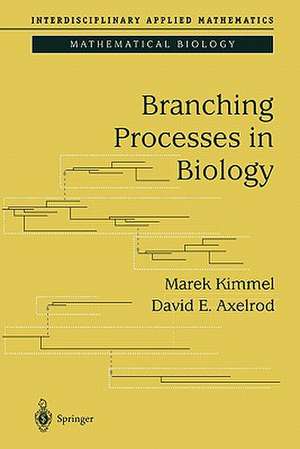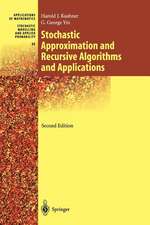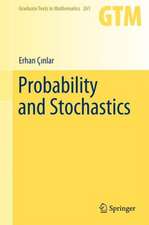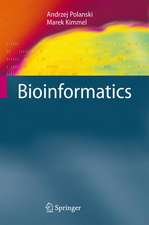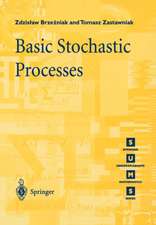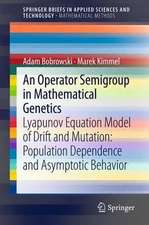Branching Processes in Biology: Interdisciplinary Applied Mathematics, cartea 19
Autor Marek Kimmel, David E. Axelroden Limba Engleză Paperback – dec 2010
This book will interest scientists who work in quantitative modelling of biological systems, particularly probabilists, mathematical biologists, biostatisticians, and cell and molecular biologists and bioinformaticians.
The authors of this monograph are a mathematician and a cell biologist who have collaborated in the field of Branching Processes for more than a decade.
| Toate formatele și edițiile | Preț | Express |
|---|---|---|
| Paperback (2) | 388.52 lei 6-8 săpt. | |
| Springer – 5 oct 2016 | 388.52 lei 6-8 săpt. | |
| Springer – dec 2010 | 632.66 lei 6-8 săpt. | |
| Hardback (1) | 505.83 lei 6-8 săpt. | |
| Springer – 17 feb 2015 | 505.83 lei 6-8 săpt. |
Din seria Interdisciplinary Applied Mathematics
- 15%
 Preț: 667.05 lei
Preț: 667.05 lei - 15%
 Preț: 487.25 lei
Preț: 487.25 lei - 20%
 Preț: 664.77 lei
Preț: 664.77 lei - 15%
 Preț: 980.97 lei
Preț: 980.97 lei - 17%
 Preț: 528.45 lei
Preț: 528.45 lei - 9%
 Preț: 630.35 lei
Preț: 630.35 lei - 18%
 Preț: 908.71 lei
Preț: 908.71 lei - 18%
 Preț: 1006.38 lei
Preț: 1006.38 lei - 15%
 Preț: 659.67 lei
Preț: 659.67 lei -
 Preț: 498.14 lei
Preț: 498.14 lei -
 Preț: 528.35 lei
Preț: 528.35 lei - 15%
 Preț: 659.02 lei
Preț: 659.02 lei - 15%
 Preț: 480.52 lei
Preț: 480.52 lei -
 Preț: 390.63 lei
Preț: 390.63 lei - 18%
 Preț: 918.61 lei
Preț: 918.61 lei -
 Preț: 388.52 lei
Preț: 388.52 lei - 15%
 Preț: 647.92 lei
Preț: 647.92 lei - 15%
 Preț: 655.60 lei
Preț: 655.60 lei - 23%
 Preț: 734.81 lei
Preț: 734.81 lei - 15%
 Preț: 660.83 lei
Preț: 660.83 lei - 18%
 Preț: 967.08 lei
Preț: 967.08 lei -
 Preț: 809.10 lei
Preț: 809.10 lei -
 Preț: 403.91 lei
Preț: 403.91 lei - 18%
 Preț: 896.84 lei
Preț: 896.84 lei - 18%
 Preț: 1004.00 lei
Preț: 1004.00 lei - 18%
 Preț: 974.19 lei
Preț: 974.19 lei -
 Preț: 399.67 lei
Preț: 399.67 lei - 23%
 Preț: 639.30 lei
Preț: 639.30 lei
Preț: 632.66 lei
Preț vechi: 744.30 lei
-15% Nou
Puncte Express: 949
Preț estimativ în valută:
121.10€ • 131.58$ • 101.79£
121.10€ • 131.58$ • 101.79£
Carte tipărită la comandă
Livrare economică 21 aprilie-05 mai
Preluare comenzi: 021 569.72.76
Specificații
ISBN-13: 9781441929587
ISBN-10: 1441929584
Pagini: 252
Ilustrații: XVIII, 232 p.
Dimensiuni: 155 x 235 x 13 mm
Greutate: 0.36 kg
Ediția:Softcover reprint of the original 1st ed. 2002
Editura: Springer
Colecția Springer
Seria Interdisciplinary Applied Mathematics
Locul publicării:New York, NY, United States
ISBN-10: 1441929584
Pagini: 252
Ilustrații: XVIII, 232 p.
Dimensiuni: 155 x 235 x 13 mm
Greutate: 0.36 kg
Ediția:Softcover reprint of the original 1st ed. 2002
Editura: Springer
Colecția Springer
Seria Interdisciplinary Applied Mathematics
Locul publicării:New York, NY, United States
Public țintă
ResearchCuprins
Motivating Examples and Other Preliminaries.- Biological Background.- The Galton-Watson Process.- The Age-Dependent Process: The Markov Case.- The Bellman-Harris Process.- Multitype Processes.- Branching Processes with Infinitely Many Types.- References.
Recenzii
From the reviews:
MATHEMATICAL REVIEWS
"The book is clearly written and provides a basic knowledge of branching processes and molecular biology. The scope of the present volume is unique in that it illustrates a paradigm in which theoretical results are simulated by biological applications and biological processes are illuminated by mathematics. It is an excellent source of information to probabilists, mathematical biologists and bioinformaticians."
M. Kimmel and D.E. Axelrod
Branching Processes in Biology
"This is a book written jointly by a mathematician and a cell biologist, who have collaborated on research in branching processes for more than a decade. In their own words, their monograph is intended for ‘mathematicians and statisticians who have had an introduction to stochastic processes but have forgotten much of their college biology, and for biologists who wish to collaborate with mathematicians and statisticians.’ They have largely succeeded in achieving their goal. The book can be strongly recommended to all students of branching processes; all libraries should have a copy." —ZENTRALBLATT MATH
"This book treats the theory of several important types of branching processes and demonstrates their usefulness by many interesting and important applications. … Mathematical theory and biological applications are nicely interwoven. This text will be useful both to mathematicians (including graduate students) interested in relevant applications of stochastic processes in biology, as well as to mathematically oriented biologists working on the above mentioned topics." (R. Bürger, Monatshefte für Mathematik, Vol. 143 (1), 2004)
"This is a significant book on applications of branching processes in biology, and it is highly recommended for those readers who are interested in the application and development of stochastic models, particularly those with interests incellular and molecular biology." (Charles J. Mode, Siam Review, Vol. 45 (2), 2003)
"Branching processes have made important contributions to biology and medicine in the areas of molecular biology, cell biology, developmental biology, immunology, evolution and ecology. … The book is clearly written and provides a basic knowledge of branching processes and molecular biology. The scope of the present volume is unique in that it illustrates a paradigm in which theoretical results are simulated by biological applications and biological processes are illuminated by mathematics. It is an excellent source of information to probabilists, mathematical biologists and bioinformaticians." (P.R. Parthasarathy, Mathematical Reviews, 2003 b)
"The theory of branching processes is an intensively developing area of mathematics, particularly stochastic processes, with many important applications in biology, medicine, physics and other natural sciences. This book contains … many examples of very interesting and successful applications of branching processes to biological and medical problems … . The book will be very interesting and useful for mathematicians, statisticians and biologists as well, and especially for researchers developing mathematical methods in biology, medicine and other natural sciences." (V.V. Anisimov, Short Book Reviews, Vol. 23 (2), 2003)
"Study of branching processes emerged from … mathematical analysis of the problem of extinction of the surnames of the British upper class. This area of stochastic processes continues to evolve and provides useful models of a large variety of far more significant biological processes. … This book is clearly a very useful compendium of work in this area, an area in which the authors have published extensively. Any mathematician contemplating work in this field would benefit from having the book on his or her shelf." (David Kault, The Australian Mathematical Society Gazette, Vol. 30 (2),2003)
"This is a book written jointly by a mathematician and a cell biologist, who have collaborated on research in branching processes for more than a decade. … their monograph is intended for ‘mathematicians and statisticians who have had an introduction to stochastic processes … and for biologists who wish to collaborate with mathematicians and statisticians.’ They have largely succeeded in achieving their goal. … The book can be strongly recommended to all students of branching processes; all libraries should have a copy of it." (Joseph M. Gani, Zentralblatt Math, Vol. 994 (19), 2002)
MATHEMATICAL REVIEWS
"The book is clearly written and provides a basic knowledge of branching processes and molecular biology. The scope of the present volume is unique in that it illustrates a paradigm in which theoretical results are simulated by biological applications and biological processes are illuminated by mathematics. It is an excellent source of information to probabilists, mathematical biologists and bioinformaticians."
M. Kimmel and D.E. Axelrod
Branching Processes in Biology
"This is a book written jointly by a mathematician and a cell biologist, who have collaborated on research in branching processes for more than a decade. In their own words, their monograph is intended for ‘mathematicians and statisticians who have had an introduction to stochastic processes but have forgotten much of their college biology, and for biologists who wish to collaborate with mathematicians and statisticians.’ They have largely succeeded in achieving their goal. The book can be strongly recommended to all students of branching processes; all libraries should have a copy." —ZENTRALBLATT MATH
"This book treats the theory of several important types of branching processes and demonstrates their usefulness by many interesting and important applications. … Mathematical theory and biological applications are nicely interwoven. This text will be useful both to mathematicians (including graduate students) interested in relevant applications of stochastic processes in biology, as well as to mathematically oriented biologists working on the above mentioned topics." (R. Bürger, Monatshefte für Mathematik, Vol. 143 (1), 2004)
"This is a significant book on applications of branching processes in biology, and it is highly recommended for those readers who are interested in the application and development of stochastic models, particularly those with interests incellular and molecular biology." (Charles J. Mode, Siam Review, Vol. 45 (2), 2003)
"Branching processes have made important contributions to biology and medicine in the areas of molecular biology, cell biology, developmental biology, immunology, evolution and ecology. … The book is clearly written and provides a basic knowledge of branching processes and molecular biology. The scope of the present volume is unique in that it illustrates a paradigm in which theoretical results are simulated by biological applications and biological processes are illuminated by mathematics. It is an excellent source of information to probabilists, mathematical biologists and bioinformaticians." (P.R. Parthasarathy, Mathematical Reviews, 2003 b)
"The theory of branching processes is an intensively developing area of mathematics, particularly stochastic processes, with many important applications in biology, medicine, physics and other natural sciences. This book contains … many examples of very interesting and successful applications of branching processes to biological and medical problems … . The book will be very interesting and useful for mathematicians, statisticians and biologists as well, and especially for researchers developing mathematical methods in biology, medicine and other natural sciences." (V.V. Anisimov, Short Book Reviews, Vol. 23 (2), 2003)
"Study of branching processes emerged from … mathematical analysis of the problem of extinction of the surnames of the British upper class. This area of stochastic processes continues to evolve and provides useful models of a large variety of far more significant biological processes. … This book is clearly a very useful compendium of work in this area, an area in which the authors have published extensively. Any mathematician contemplating work in this field would benefit from having the book on his or her shelf." (David Kault, The Australian Mathematical Society Gazette, Vol. 30 (2),2003)
"This is a book written jointly by a mathematician and a cell biologist, who have collaborated on research in branching processes for more than a decade. … their monograph is intended for ‘mathematicians and statisticians who have had an introduction to stochastic processes … and for biologists who wish to collaborate with mathematicians and statisticians.’ They have largely succeeded in achieving their goal. … The book can be strongly recommended to all students of branching processes; all libraries should have a copy of it." (Joseph M. Gani, Zentralblatt Math, Vol. 994 (19), 2002)
Textul de pe ultima copertă
This book provides a theoretical background of branching process and discusses their biological applications. Branching processes are a well-developed and powerful set of tools in the field of applied probability. The range of applications considered includes molecular biology, cellular biology, human evolution, and medicine. The branching processes discussed include Galton-Watson, Markov, Bellman-Harris, Multitype, and General Processes. As an aid to understanding specific examples, two introductory chapters and two glossaries are included that provide background material in mathematics and in biology.
The book will be of interest to scientists who work in quantitative modeling of biological systems, particularly probabilists, mathematical biologists, biostatisticians, cell biologists, molecular biologists, and bioinformaticians.
The authors are a mathematician and cell biologist who have collaborated for more than a decade in the field of branching processes in biology.
Caracteristici
The authors come from mathematics and cell biology Examples discussed in the context of the relevant mathematics
Notă biografică
Marek Kimmel is a Professor of Statistics at Rice University. Professor Kimmel's research focuses on probabilistic modeling and statistical analysis in biosciences. He is particularly interested in applications of his work in cell and molecular biology and in cancer research. From the mathematical point of view, his interests lie in Markov and branching processes and in estimation theory. David Axelrod is a Professor at Rutgers University, where he works in a laboratory focusing on the heterogeneity and progression of human breast cancers using methods of molecular biology, cell biology, computer simulation, and mathematical modeling.
